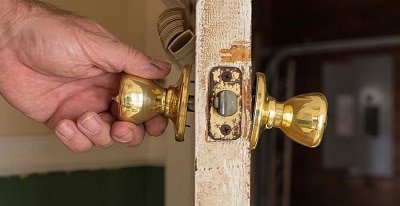
When you twist it to enter or exit your home, you expect it to work smoothly, right? Yet, when the door is open, it feels wobbly, as if it might just fall off any second. This common issue can often be baffling, especially if you’re not a DIY enthusiast. But don’t worry—understanding why this happens is just a matter of putting two and two together. Let’s dive into the mechanics of door knobs, what makes them tick, and how you can troubleshoot this pesky problem.
Understanding Door Knob Mechanics
To figure out why your door knob feels loose when the door is open, let’s first explore how these gadgets work. A door knob is essentially a lever that operates a latch. When you turn the knob, it pulls a mechanism that moves the latch in and out of the strike plate, allowing the door to open or close.
The main components include the handle, the spindle (the rod connecting the two knobs), and the latch. If any of these parts are out of alignment or worn down, you might feel a looseness. It’s like a bicycle chain; if it’s not tight, it won’t function smoothly.
Common Causes of a Loose Door Knob
Several factors can contribute to that loose feeling you experience. Here are some of the most common culprits:
- Worn-out screws: Over time, the screws holding the knob in place can become loose, especially with frequent use.
- Damaged spindle: If the spindle is broken or stripped, it may cause the knob to wobble.
- Misalignment: If the door is not hung properly, it can affect how the knob operates, making it feel loose.
- Worn latch mechanism: A latch that has seen better days may not engage properly, leading to that loose sensation.
Here’s the thing: ignoring this issue can lead to more significant problems. A loose knob can eventually cause the latch to fail, meaning you’ll have a door that can’t close properly. And who wants that? So, let’s look at how you can fix this.
How to Tighten a Loose Door Knob
Fixing a loose door knob is often easier than you might think. Here’s a simple step-by-step guide to tighten it up:
1. Gather Your Tools: You’ll need a screwdriver (usually a Phillips head) and potentially a wrench if the knob requires it.
2. Locate the Screws: Most door knobs have screws located on the side or the back of the knob. You’ll see them once the knob is turned or pulled slightly.
3. Tighten the Screws: Turn the screws clockwise until they’re snug. Be careful not to overtighten, as this could strip the screws or damage the knob.
4. Check the Spindle: If the knob is still loose, try removing it to see if the spindle is damaged or worn. If it is, you might need to replace it.
5. Reassemble: Finally, put everything back together and test the knob. It should feel tighter and more secure.
By following these steps, you’ll often solve the issue without needing professional help.
When to Replace Your Door Knob
Sometimes, tightening just isn’t enough. If you’ve tried fixing it and the door knob still feels loose, it may be time to consider replacing it. Here are some signs that a new knob might be in your future:
- Rust or corrosion: If your knob is rusty or corroded, it might be time for a fresh start.
- Frequent looseness: If you find yourself constantly tightening it, the knob may simply be too worn out.
- Difficulty operating: If the knob is hard to turn or the latch doesn’t engage properly, a replacement is likely necessary.
Let’s be honest, sometimes a fresh door knob can elevate the look of your door too. It’s like getting a new hairstyle; you might not realize how much you needed it until it’s done!
Preventive Measures for Future Issues
Once you’ve fixed or replaced your door knob, you might be wondering how to keep it feeling secure over time. Here are some preventive measures to consider:
1. Regular Maintenance: Once a year, give your door knob a little check-up. Tighten screws, clean the knob, and check for any signs of wear or damage.
2. Use Lubricant: A little lubrication can go a long way. Apply a silicone-based lubricant to the latch every few months to keep everything moving smoothly.
3. Watch Your Door’s Alignment: Ensure your door is hanging correctly. If it tends to sag or doesn’t close properly, it may put extra strain on the knob.
By keeping an eye on your door knob and following these tips, you should be able to enjoy a fully functional knob for years to come.
A loose door knob when the door is open might seem like a small nuisance, but it’s something that can lead to bigger issues down the line. By understanding the mechanics of your door knob and knowing how to troubleshoot common problems, you can save yourself time, money, and a whole lot of frustration.
Remember, whether you’re tightening screws or replacing the knob altogether, a little effort goes a long way in maintaining your home. So next time you twist that knob, you can do so with confidence—knowing it won’t be the loose friend at the party but rather a dependable part of your daily life!